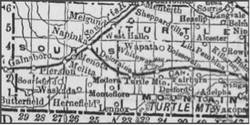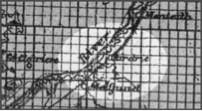By Tyler Bugg

La Vérendrye was the first European visitor to this region and he started the process of applying European names to local landmarks. He described Turtle Mountain in 1738 as “The Blue Jewel of the Plains,” and his sons named the currentSouris River the “Rivière St Pierre” to honor their father. Eventually the river and mountain gained their current names. The Cree name for Turtle Mountain was Mikinakwuche, meaning literarily “turtle” or “tortoise,” most likely for the reptilian inhabitants of the area.
As settlements, towns and villages began to spring up and it came time to name things, there were several factors in play. The first settlers often sought links with their home villages; the railway companies had their ideas; and the post office department had a say.
Towns named after the first inhabitants, their hometowns in Europe, or the financial backers of the railroad began to dot the area. Deloraine was named after the first postmaster’s home in Scotland.
Boissievain (originally Cherry Creek) was named after Adolf Boissevain, a businessman in Belgium who first sold shares for the Canadian Pacific Railway in Europe. Pierson was named after another Belgian banker, Jean L. Pierson. These names serves as reminders that the C.P.R.had significant internationally financial backing.
Medora was named by surveyors who stayed with Robert and Medora May Campbell from Minto when they were first surveying the area. Coulter and Coultervale were most likely named after pioneer man, Postmaster F. Coulter. Lauder was either named after the town that the first settlers arrived from in Ontario, or by the CPR in honor of the Archdeacon John Strutt Lauder, Rector of Christ Church in Ottawa.
Hartney may claim to be one of the few settlement-era railway towns whose name was actually changed by popular demand. Upon learning that the C.P.R had chosen the name Airdrie for the new town, settlers protested that Hartney, used already for the post office that pioneer James Hartney had established on his nearby farm, better captured the essence of the neighbourhood.
Popular opinion won out – Airdrie became Hartney.
Other towns took names from Aboriginal languages.
Wakopa means “stream” in Dakota. Canupawakpa means “clay stream”. It was the name given to a source pipe-making clay, the stream we call Pipestone Creek.
Some say Napinka means “double” or “equal to two,” most likely due to the early settlers dreams that Napinka would be larger than any town in the region. Others insist that name means running water. My favorite explanation involves a long story about a sought after aboriginal maiden named Napink. Local historian
George Pue explained the punch line this way:
“The brave had to explain to the settlers that she was now married. The settlers replied in two ways, “Napink no” or Napink ah”
It makes a good story.

The source of the name “Melita” is somewhat disputed. The first suggestion, Manchester, was rejected by the Post Office because it was already taken. The townsfolk decided to have a meeting after a church service to decide on the name. One story is that the Sunday School Superintendent, a Scottish Presbyterian, proposed Melita. Melita is the original name of the island of Malta where the Apostle Paul was shipwrecked, according to Acts 28:1, which happened to be the lesson of the day. Others claim that the inspiration came from Melita Roche, the godchild of the fourth Lieutenant-Governor of Manitoba, the Honourable Joseph Cauchon. We are sure it was a local choice, we’re just not sure why!
Another interesting series of names can be seen in the (former) municipalities in the area. Arthur, Edward and Albert are named for British Royalty.
The RM of Cameron was named after the Honourable J.D. Cameron, Attorney General of Manitoba from 1896 to 1900. Napinka resident Major Cates named the RM of Brenda after his daughter, while the RM of Morton was named after George Morton, the “Cheese King of Canada” a successful businessman in Boissevain. The RM of Winchester was named after the historical city of the same name in England.
Manitoba is as good a place as any to see what happens when one group of people moves into another’s land. Much changes – including the names. Those new names were the result of homeland sentimentality, along with an impulse to honour the men and women that braved the wilderness. The patrons of the railway, royalty, and, in some cases the wishes of the CPR and the Post Office, all played a role.
. . . . .
Author: Tyler Bugg
Update
In 2014 Ted Kenner, a former Melita resident wrote to tell us that::
"We were told as children(1940s) that it was named for Melita Townsend, sp., the first white girl born in the region. When I attended the old school in the 1940s, now your museum I think,Mr. Dyer was the school janitor and his daughter Julia kept a pretty good history of Melita. Her records may be tucked away somewhere."
Sources:
Boissevain History Book Committee. Beckoning Hills Revisited. “Ours is a Goodly Heritage” Morton – Boissevain 1881 – 1981. Altona. Friesen Printing, 1981 Brenda History Committee. Bridging Brenda Vol. 1. Altona. Friesen Printers, 1990 Melita - Arthur History Committee. Melita: Our First Century. Altona. Friesen Printers, 1983 Deloraine History Book Committee. Deloraine Scans a Century 1880 - 1980: Altona. Friesen Printers, 1980
Maps: Adapted from:
Dawson, S. E. Map of the Province of Manitoba Showing the Division into Provincial Counties [Ottawa: 1893.
Matthews-Northrup Co. Map of Manitoba, British Columbia and the NorthWestTerritories (1897) Image Courtesy of University of Manitoba Archives & Special Collections
